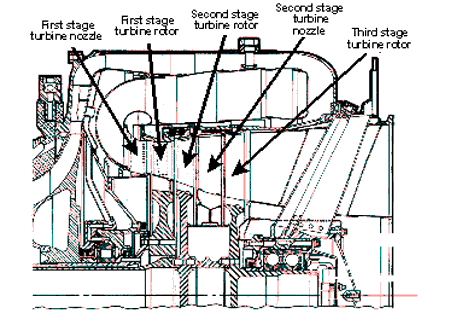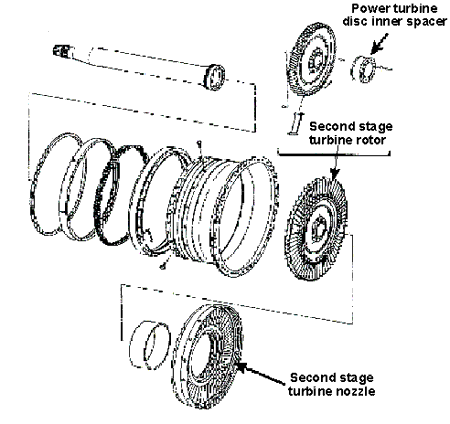Engine Power Loss
Transwest Helicopters Ltd.
Bell 214B-1 (helicopter) C-GTWH
Smithers, British Columbia, 10 nm S
The Transportation Safety Board of Canada (TSB) investigated this occurrence for the purpose of advancing transportation safety. It is not the function of the Board to assign fault or determine civil or criminal liability. This report is not created for use in the context of legal, disciplinary or other proceedings. See Ownership and use of content. Masculine pronouns and position titles may be used to signify all genders to comply with the Canadian Transportation Accident Investigation and Safety Board Act (S.C. 1989, c. 3).
Summary
The Bell 214B-1helicopter, C-GTWH, serial number 28017, with two pilots onboard, was engaged in heli-logging operations in Telkwa Pass, about 10 nautical miles south of Smithers, British Columbia. The helicopter was carrying a sling load of logs at about 500 feet above ground level when the engine lost power and the low-rotor warning horn sounded. The load was released and the pilot-in-command conducted an autorotation to a logged-off area at approximately 1530 Pacific daylight time. On landing, the main rotor blades struck terrain, and the aircraft rolled onto its side and was substantially damaged. Neither pilot was injured. The engine continued to operate until the crew shut it down by selecting the fuel shut-off valve off.
Factual information
The helicopter was owned and operated by Transwest Helicopters Ltd. Both pilots were appropriately certificated and trained for the type of flight being conducted. At the time of the accident, the helicopter had about 500 pounds of fuel onboard and was operating in visual meteorological conditions.
The helicopter was equipped with a single, Honeywell (formerly Lycoming) model T5508D, turboshaft engine, serial number LE31958. The engine was imported from Japan on 24 January 2002 with 6055.5 hours TSN (time since new) and 2070.1 hours TSO (time since overhaul). Transwest Helicopters completed an overhaul of the engine on April 2, and on April 3, installed the engine in C-GTWZ (a Bell 214B helicopter operated by Transwest Helicopters). The engine remained in C-GTWZ for 652.9 hours during which time significant maintenance actions were performed on the engine. This maintenance included the following:
- replacement of engine wiring harness part number 2-300-274-05 - twice;
- replacement of the torquemeter kit - twice;
- removal of the accessory gearbox to investigate ferrous metal on the chip plug;
- replacement of the scavenge oil pump;
- replacement of the starter gearbox due to metal generation;
- replacement of a leaking oil line and a leaking oil fitting;
- replacement of the second-stage turbine cylinder seal (bump gasket); and,
- removal of the engine from C-GTWZ to investigate an oil leak.
The Engine Record Technical Logbook indicates that following removal from C-GTWZ (at 652.9 hours TSO) the engine was reassembled, inspected, and prepared for return to service on August 1. The engine was installed in C-GTWH on August 2, where it accumulated a further 31.3 hours in 6 days for a total of 684.2 hours TSO at the time of the accident.
A post-accident teardown revealed extensive internal damage to the combustion section of the engine. The turbine housing was heavily dented outwards in a band coincident with the third turbine (part number 2-140-050-36) blade path, and included at least one puncture. The exhaust diffuser showed heavy impact damage to the struts, and tearing and folding of the outer ring. No remarkable damage was noted to the bearings or bearing housing.
The gas flow through the engine downstream of the combustion chamber is through the first-stage nozzle, the first and second-stage turbines, the second-stage nozzle, and the third-stage turbine (see figures 1 and 2). The first-stage nozzle and first-stage turbine had no significant damage. The second-stage turbine (part number 2-140-040-45), which is coupled to the third-stage turbine via the power turbine disc inner spacer, showed tears and dents on the trailing edges of the blades, mostly toward the blade tips. Four of the blades had tip shrouds missing. The second-stage nozzle (part number 2-140-240-01) had largely disintegrated. A cluster of nine vanes remained attached; the vanes of that cluster were torn and dented from the trailing edge side, with the outboard half being the most affected. The third-stage turbine blading was completely destroyed; only blade roots and stubs remained in the disc.
Certain key components, including the second-stage nozzle and the third-stage turbine, were sent to the TSB Engineering Branch for further examination and analysis.
The fracture surfaces of the third-stage turbine blades were examined for signs of any progressive failure mechanism. All fracture surfaces exhibited topography consistent with an impact and overstress load condition. No indication of fatigue or other type of time dependant failure mode was found. The leading edges of the blade stubs had been abraded due to contact with the second nozzle.
Although the second-stage nozzle had largely disintegrated, a detailed examination of the remaining structure was conducted. The aft portion of the inner vane support was substantially worn away from being in contact with the forward side of the rotating third turbine. A sample of cracked aft inner support sheet metal was removed and an examination of the fracture surfaces was conducted revealing that the prevailing fracture topography was an oxidized intergranular surface with evidence of multiple secondary cracking. The second-stage nozzle is a brazed assembly. Examination of the remaining seams revealed that the braze between the aft seal and the inner shroud was not uniform and that several areas were nearly devoid of braze. Also, the second-stage nozzle had an unauthorised "window patch" weld repair on the outer ring, and the nozzle serial number appeared to have been altered.
Detailed examination of the serial number inscribed on the second-stage nozzle removed from the engine during the post-accident teardown determined the nozzle serial number to be OC002. This serial number does not match that of any second-stage nozzle manufactured by Honeywell/Lycoming. Maintenance records provided several months after the accident show that nozzle serial number OC002 was sent on 17 January 2002 to have cracks repaired, and that on 28 January 2002 the nozzle was inspected using fluorescent penetrant and subsequently rejected by the company performing the NDT (non-destructive testing). No documentation was found to show that the nozzle was subsequently repaired or determined to be serviceable. On 02 April 2002, four months before the accident, the nozzle was installed in the engine while the engine was in the test cell following the engine overhaul. No maintenance record was found documenting the installation of the subject nozzle. Transwest Helicopters component records (C. A. L. M. Maintenance Tracking Report) incorrectly indicate that on the day of the accident, the second-stage nozzle installed in the engine was serial number 78M005. The Lycoming Engine Log (Major Component Record) indicates that the first and second-stage nozzles installed in the engine were serial number 78M005, which is also not correct.
The engine run-up following overhaul was conducted in a test cell that was not approved by the engine manufacturer for the testing of aircraft engines. The unapproved test cell was not instrumented to measure several parameters required by the engine manufacturer. Calculations to determine engine performance were based in part on measurements that could not be taken in the unapproved test cell. As well, at least one of the calculations done using the test cell run data was done incorrectly.
Records of engine overhaul and engine installation in C-GTWH could not be found in several technical logs required to contain the information.
Honeywell's data base includes one other instance in which failure of the second-stage nozzle in a variant of the T5508D engine was the likely cause of engine failure.
Analysis
Immediately prior to the release of the sling load from the helicopter, the engine lost power. Although the engine continued to run during the autorotation and subsequent roll-over, it was not producing any useful power. Post-accident inspection of the engine revealed damage to the second-stage nozzle and third-stage turbine that would have caused the engine to stop producing power but continue to operate.
Damage to the second-stage nozzle and third-stage turbine indicate that the two components contacted each other while the engine was operating at significant rpm. The damage pattern suggests that the failure sequence was initiated by a loss of integrity of the second-stage nozzle, possibly due to extensive cracking or separation of a braze joint. Such damage is likely to have caused a remarkable loss in delivered engine power, yet insufficient to cause the engine to stop.
About six months before the accident, second-stage nozzle serial number OC002 was rejected following an NDT examination. However, the nozzle was installed in the engine while the engine was in the test-cell two months later. Several significant engine maintenance issues occurred during the 652.9 hours the engine was installed in C-GTWZ following the engine overhaul. It is not known if these issues were related to the failing nozzle.
The engine run-up following its overhaul was conducted in a test cell that was not approved by the engine manufacturer for the purpose of testing engines installed in aircraft. The test cell was not suitable because it lacked instruments to measure several parameters that the engine manufacturer required for re-certification of its engines. As a result, calculations to determine engine performance were based on incomplete and inaccurate data. As well, at least one of the calculations done using the test cell run data was done incorrectly. Accordingly, the engine did not meet the engine manufacturer's approved certification specifications, and it was not airworthy.
The following laboratory report was completed:
- LP 075/2002 – Turbine Components
Findings
Findings as to causes and contributing factors
- The engine failed as the result of the second-stage nozzle failing and coming into contact with the third-stage turbine.
- The second-stage nozzle failed, possibly due to extensive cracking or separation of a braze joint.
- The second-stage nozzle failed non-destructive testing and was not subsequently repaired or certified airworthy; however, it was installed in the engine.
Findings as to risk
- The engine run following overhaul was performed in an unapproved test cell and was not conducted in accordance with the appropriate procedures resulting in incomplete and inaccurate engine performance data
- The documents relating to engine components, specifically for the second-stage nozzle and engine installation, were incomplete and incorrect.
This report concludes the Transportation Safety Board's investigation into this occurrence. Consequently, the Board authorized the release of this report on .

